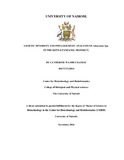| dc.contributor.author | Kamau, Catherine, W | |
| dc.date.accessioned | 2017-01-03T07:09:51Z | |
| dc.date.available | 2017-01-03T07:09:51Z | |
| dc.date.issued | 2016 | |
| dc.identifier.uri | http://hdl.handle.net/11295/98546 | |
| dc.description.abstract | Baobab is a widely used indigenous tree species in Africa. It is valued in the food and cosmetic industries for its high vitamin C content in its fruit pulp and its seed oil respectively. It has a high potential for domestication. However, baobab populations are declining due to climatic changes and human development activities. It is therefore necessary to carry out molecular characterization in order to understand the genetic variation and population clustering which will aid in developing conservation strategies for the species. This study evaluated the geographical distribution of A. kilima and A. digitata in the Kenya /Tanzania transect given the difficulty in distinguishing the species visually. It also determined the level of genetic variation and differentiation of 8 populations of Adansonia species sampled from the Kenya/Tanzania transect. The genetic variation was determined using 16 microsatellite markers at 16 loci in 62 trees. An analysis of Molecular Variance (AMOVA) showed a low level of genetic variation among populations: 96% within populations and 4% among populations. This was due to high gene flow among the populations. The total genetic differentiation coefficient was (PhiPT= 0.042, P < 0.001). A UPGMA dendogram and neighbor joining radial tree generated by DARwin 6 grouped the genotypes into 3 distinct clusters. Cluster 1 consisted of Kenyan populations, Cluster 2 both Kenyan and Tanzanian populations and Cluster 3 consisted of Tanzanian populations. There was some general correlation between clustering and geographic origin indicating some degree of genetic structuring in the populations. The average heterozygosity (H) values ranged from 0.1529 to 0.2736. The percentage of polymorphic loci was based on a 99% criterion and it ranged from 34.0299 to 63.8806. Kondo population was the most diverse with a mean diversity of 0.194 and 17 private alleles. The two species (A. digitata and A. kilima) being superficially similar, were differentiated on the basis of phylogenetic analysis. The nuclear ITS region (ITS-1, ITS-2), amplified using 2 primers (ITS LEU/4 and ITS S2F/S3R) was used to examine phylogenetic relationships within Adansonia and determine whether A. digitata evolved from A. kilima. Phylogenetic analysis of the ITS region was not informative enough to distinguish between Adansonia digitata and Adansonia kilima or determine whether A. digitata evolved from A. kilima. | en_US |
| dc.language.iso | en | en_US |
| dc.publisher | University of Nairobi | en_US |
| dc.rights | Attribution-NonCommercial-NoDerivs 3.0 United States | * |
| dc.rights.uri | http://creativecommons.org/licenses/by-nc-nd/3.0/us/ | * |
| dc.subject | Genetic Diversity and Phylogenetic Analysis of Adansonia Spp | en_US |
| dc.title | Genetic Diversity and Phylogenetic Analysis of Adansonia Spp. In the Kenya/Tanzania Transect. | en_US |
| dc.type | Thesis | en_US |



